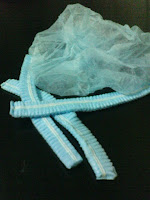PERSONAL PROTECTIVE EQUIPMENT
Some may say complete laboratory attire is not necessary – definitely wrong. Accidents do happen. It may come when least expected: a splash of a reagent into the face, a skin contact to a toxic substance, or even spill of a solution onto your body. Toxic or non-toxic, hazardous or not, flammable or not, whatever you are handling, testing and experimenting, a complete personal protective equipment is necessary. These equipment are not intended to be accessories or not even to be a disturbance in the laboratory works. These are designed to serve as protection and shield from various accidents that may happen. As it name implies, personal protective equipment, these are materials that keep you protected. Wearing a complete set of personal protective equipment would benefit us. Nothing would happen bad to you if you do wear a complete set.

Laboratory gown is necessary. It protects your body, arms and legs from any accidents. It serves as your cover and protective coat during laboratory work. It covers our bodies so not to be exposed to any chemical or substance can induce harm or damage in our bodies. Laboratory gown itself should be clean and free form any contamination. It must be properly fit in our body physique, not too fit nor too large.
Gloves are protective equipment for the hands. It must neither too small nor too big for your hands. You must wear the correct size of the glove for your hands: rightly fitted and comfortable. Too small gloves give you the tendency to limit your hand movements and make your hands sore. Too big gloves for your hands tend to make you prone to accidents and cannot work easily. Gloves are very useful in the laboratory set-up. It makes your hands secure when handling toxic or infectious solutions. Disposable gloves should not be re-used and properly disposed right after used. Any damaged glove or gloves with holes should not be used and must be replaced immediately.
Masks should cover the nose and the mouth. It is used to prevent entry of any chemical or substance in the body through inhalation or ingestion. It must not be too tight for you to wear that it comes to a point that you have hard time breathing. It must not also be too loose that it tends to be useless to wear.
Goggles protect your eyes during laboratory works. It protects the eyes from any splash or splatter or chemical or substances. Goggles are very important because it keeps our eyes safe and secured. Certain chemicals and reagents can easily destroy our eyes making us blind, so wear goggles.
Hair cap is used to make the hair intact and no hair can fall to the working area. It is essential especially for the women with long beautiful hair because it keeps the hair safe and out of danger. Wearing hair cap is important, just like when dealing with flame because long hair are at high risk in being burn if left untied. Even though your hairstyle is destroyed or messed up after wearing hair cap, it is better than exposing yourself in danger.
When performing laboratory procedures, it is important to wear these things. Just like when assaying oxytocin concentration or other hormone, complete personal protective equipment is important. In measuring oxytocin concentration on the body, you deal with the sample of the patient, reagents and chemicals to be used, and solutions that can be detrimental. So to prevent any disaster that may happen, PPE are very useful.
PERSONAL PROTECTIVE EQUIPMENT are indeed very important. Wearing them makes your laboratory life safe and coordinated.






7 comments